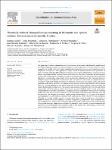Thermally-induced clumped isotope resetting in belemnite and optical calcites: Towards material-specific kinetics
| dc.contributor.author | Looser, N | |
| dc.contributor.author | Petschnig, P | |
| dc.contributor.author | Hemingway, JD | |
| dc.contributor.author | Fernandez, A | |
| dc.contributor.author | Morales Grafulha, L | |
| dc.contributor.author | Perez-Huerta, A | |
| dc.contributor.author | Vickers, ML | |
| dc.contributor.author | Watanabe, Sayaka | |
| dc.contributor.author | Schmidt, MW | |
| dc.contributor.author | Bernasconi, SM | |
| dc.date.accessioned | 2023-04-24T10:41:38Z | |
| dc.date.available | 2023-04-24T10:41:38Z | |
| dc.date.issued | 2023-03-29 | |
| dc.identifier.issn | 0016-7037 | |
| dc.identifier.issn | 1872-9533 | |
| dc.identifier.uri | https://pearl.plymouth.ac.uk/handle/10026.1/20752 | |
| dc.description.abstract |
The application of carbonate clumped isotope (Δ47) thermometry in deep-time is often limited by modification of the original temperature signal by thermal resetting. New modeling approaches to estimate the initial isotopic composition of partially reset calcites and maximal burial temperatures, however, open promising avenues in temperature reconstruction. Such approaches strongly depend on laboratory-derived kinetic parameters of calcite materials, which may differ in their microstructure, water content and distribution, and minor and trace element composition, and thus may have different resetting kinetics. The rostra of belemnites, an extinct group of mollusks with a wide temporal and spatial occurrence in the Mesozoic, have been extensively used for deep-time paleoclimate reconstructions using oxygen isotope geochemistry. Belemnites are also important targets for clumped isotope-based temperature reconstructions, but often are found to have reset Δ47 compositions. Here, we present results from heating experiments on belemnite rostral calcite and optical calcite and provide belemnite-specific kinetic parameters for clumped isotope resetting. We show that belemnite calcite is altered faster and at lower temperatures than optical calcite and all other calcites reported in previous studies. We suggest that fast initial resetting results from oxygen isotope exchange of belemnite calcite with internal skeletal water present as fluid inclusions or organic-derived water, a process completed within 2–4 min at the experimental temperatures used here. Extrapolation to geological timescales using different solid-state bond reordering models shows that belemnite calcite resetting starts at lower burial temperatures than brachiopod, spar, and optical calcites. This susceptibility to thermal resetting results in a measurable (+3 °C) increase of the apparent Δ47 temperature even under shallow to moderate burial conditions (i.e., 40–50 °C for 106–107 years timescales). Following the overprint to higher apparent Δ47 temperatures during burial, the belemnite Δ47 may further re-equilibrate during exhumation resulting in a decrease of apparent Δ47 temperatures. Such “retrograde resetting” is similar to what is observed for carbonatites and marbles during cooling, and may cause underestimation of the thermal resetting a sample experienced during its geological history. Overall, our results demonstrate the importance of material-specific kinetic parameters and we urge caution when interpreting Δ47-derived temperatures of biogenic carbonates from deep-time archives. | |
| dc.format.extent | 1-15 | |
| dc.language | en | |
| dc.publisher | Elsevier BV | |
| dc.subject | Carbonate clumped isotopes | |
| dc.subject | Solid -state bond reordering | |
| dc.subject | Mineral-water isotopic exchange | |
| dc.subject | Belemnite rostral calcite | |
| dc.subject | Optical calcite | |
| dc.title | Thermally-induced clumped isotope resetting in belemnite and optical calcites: Towards material-specific kinetics | |
| dc.type | journal-article | |
| dc.type | Journal Article | |
| plymouth.author-url | https://www.webofscience.com/api/gateway?GWVersion=2&SrcApp=PARTNER_APP&SrcAuth=LinksAMR&KeyUT=WOS:000990636500001&DestLinkType=FullRecord&DestApp=ALL_WOS&UsrCustomerID=11bb513d99f797142bcfeffcc58ea008 | |
| plymouth.volume | 350 | |
| plymouth.publication-status | Published | |
| plymouth.journal | Geochimica et Cosmochimica Acta | |
| dc.identifier.doi | 10.1016/j.gca.2023.03.030 | |
| plymouth.organisational-group | |Plymouth | |
| plymouth.organisational-group | |Plymouth|Research Groups | |
| plymouth.organisational-group | |Plymouth|Faculty of Science and Engineering | |
| plymouth.organisational-group | |Plymouth|Faculty of Science and Engineering|School of Geography, Earth and Environmental Sciences | |
| plymouth.organisational-group | |Plymouth|Research Groups|Marine Institute | |
| plymouth.organisational-group | |Plymouth|REF 2021 Researchers by UoA | |
| plymouth.organisational-group | |Plymouth|Users by role | |
| plymouth.organisational-group | |Plymouth|Users by role|Academics | |
| plymouth.organisational-group | |Plymouth|REF 2021 Researchers by UoA|UoA07 Earth Systems and Environmental Sciences | |
| plymouth.organisational-group | |Plymouth|Users by role|Researchers in ResearchFish submission | |
| dcterms.dateAccepted | 2023-03-23 | |
| dc.date.updated | 2023-04-24T10:41:33Z | |
| dc.rights.embargodate | 2023-4-25 | |
| dc.identifier.eissn | 1872-9533 | |
| dc.rights.embargoperiod | forever | |
| rioxxterms.versionofrecord | 10.1016/j.gca.2023.03.030 |


